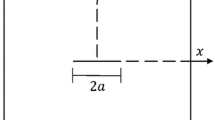Abstract
The stress intensity factor is a useful tool for predicting material failure and describing the stress states of brittle materials. We present a technique to calculate the stress intensity factor for a linear elasticity problem on a cracked domain with an enriched partition of unity method. We use a particular partition of unity function, which is piecewise polynomial and has wide flat-top region. The flat-top area in the partition of unity function helps the displacements and the stress fields in the vicinity of the crack tip to be accurately represented, even with a coarse background mesh. Among other methods for calculating the stress intensity factor, we find that the direct extraction method is the most accurate and efficient one given a relatively coarse background mesh for the enriched partition of unity method.
Similar content being viewed by others
References
B. Szabo and I. Babuska, Finite Element Analysis (John Wiley & Sons, New York, 1991) p. 176.
T. Pin and T. H. H. Pian, Int. J. Solids Struct. 9, 3 (1973).
T. J. Barth and J. A. Sethian, J. Comput. Phys. 145, 1 (1998).
N. Möes, J. Dolbow and T. Belytscheko, Int. J. Numer. Meth. Eng. 46, 1 (1999).
J. Dolbow et al., Finite Elem. Anal. Des. 36, 235 (2000).
R. P. Fedkiw, J. Comput. Phys. 175, 1 (2002).
T. Menouillard and T. Belytschko, Acta Mech. 213, 1 (2010).
H. Sauerland and T. P. Fries. J. Comput. Phys. 230, 9 (2011).
I. Babuška and J. Melenk, Int. J. Numer. Meth. Eng. 40, 727 (1996).
T. Strouboulis et al., Comput. Meth. Appl. M. 190, 4081(2001).
I. Babuška, U. Banerjee and J. Osborn, Acta Numer. 12, 1 (2003).
I. Babuška et al., J. Comput. Appl. Math. 218, 1 (2008).
H. S. Oh et al., Comput. Meth. Appl. M. 197, 45 (2008).
H. S. Oh et al., Comput. Mech. 40, 3 (2007).
H. S. Oh et al., J. Comput. Phys. 229, 5 (2010).
T. Belytschko, Y. Y. Lu and L. Gu, Eng. Fract. Mech. 51, 2 (1994).
M. Fleming et al., Eng. Fract. Mech. 40, 1483 (1997).
W. T. Hong, Adv. Math. Phys. 2017, 1 (2017).
W. T. Hong, Adv. Math. Phys. 2016, 1 (2016) and references therein.
D. Roylance, Mechanics of Materials (John Wiley & Sons, New Jersey, 1995), p. 109.
S. K. Chan, I. S. Tuba and W. K. Wilson, Eng. Fract. Mech. 2, 1 (1970).
W. T. Hong and P. S. Lee, Appl. Math. Comput. 219, 8687 (2013).
E. E. Gdoutos, Fracture Mechanics (Kluwer Academic Publisher, Massachusetts, 1993), p. 53.
Author information
Authors and Affiliations
Corresponding author
Rights and permissions
About this article
Cite this article
Hong, WT. Stress intensity factor extraction from the enriched partition of unity solution for a cracked linear elastic medium. Journal of the Korean Physical Society 70, 245–251 (2017). https://doi.org/10.3938/jkps.70.245
Received:
Accepted:
Published:
Issue Date:
DOI: https://doi.org/10.3938/jkps.70.245




